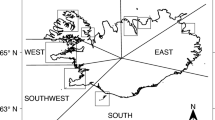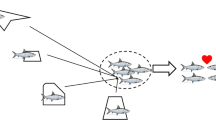Abstract
Movement, site fidelity and connectivity have important consequences for the evolution of population structure and therefore the conservation and management of a species. In this study photographs of naturally marked killer whales collected from sites across the Northeast Atlantic are used to estimate fidelity to sampling locations and movement between locations, expressed as transition probabilities, pt, using maximum likelihood methods. High transition probabilities suggest there is high inter-annual site fidelity to all locations, and large-scale movement between the spawning and wintering grounds of both Norwegian and Iceland stocks of Atlantic herring. There was no evidence of movement between the Norwegian herring grounds and Icelandic herring grounds, or between the mackerel fishing grounds and the herring fishing grounds. Thus the movement of predictable and abundant prey resources can lead to intrinsic isolation in this species We also find movement between the Northern Isles, Scotland and East Iceland. An association network indicates that killer whales predating seals around the Northern Isles, Scotland are linked to the community of killer whales that follow the Icelandic summer-spawning herring. This adds support to existing evidence of a broad niche width in some populations.


Similar content being viewed by others
References
Andrews RD, Pitman RL, Ballance LT (2008) Satellite tracking reveals distinct movement patterns for Type B and Type C killer whales in the southern Ross Sea, Antarctica. Polar Biol 31:1461–1468
Baker CS, Palumbi SR, Lambertsen RH, Weinrich MT, Calambokidis J, O’Brien J (1990) Influence of seasonal migration on geographic distribution of mitochondrial DNA haplotypes in humpback whales. Nature 344:238–240
Bigg MA (1982) An assessment of killer whale (Orcinus orca) stocks off Vancouver Island, British Columbia. Rep Int Whaling Comm 32:655–666
Bisther A, Vongraven D (1995) Studies of the social ecology of Norwegian killer whales (Orcinus orca). In: Blix AS, Walloe L (eds) Whales, seals, fish and man. Elsevier, Amsterdam, pp 169–176
Bisther A, Vongraven D (2001) Killer whales feeding on both mammals and fish: A transient, resident or opportunistic type? Abstracts from society for marine mammalogy Biennial conference, Vancouver BC
Block BA, Teo SLH, Walli A, Boustany A, Stokesbury MJW, Farwell CJ, Weng KC, Dewar H, Williams TD (2005) Electronic tagging and population structure of Atlantic bluefin tuna. Nature 434:1121–1127
Bolt HE, Harvey PV, Mandelberg L, Thompson PM, Foote AD (2009) Occurrence of killer whales in Scottish inshore waters: temporal and spatial patterns relative to the distribution of declining harbour seal populations. Aquat Cons Mar Freshw Ecosys 19:671–675
Bonfil R, Meyer M, Scholl MC, Johnson R, O’Brien S, Oosthuizen H, Swanson S, Kotze D, Paterson M (2005) Transoceanic migration, spatial dynamics, and population linkages of white sharks. Science 310:100–103
Borgatti SP (2002) Netdraw: graph visualization software. Analytical Technologies, Harvard
Boustany AM, Davis SF, Pyle P, Anderson SD, Le Boeuf BJ, Block BA (2002) Expanded niche for white sharks. Nature 415:35–36
Caughley G (1994) Directions in conservation biology. J Anim Ecol 63:215–244
Foote AD, Griffin RM, Howitt D, Larsson L, Miller PJO, Hoelzel AR (2006) Killer whales are capable of vocal learning. Biol Lett 2:509–512
Foote AD, Newton J, Piertney SB, Willerslev E, Gilbert MT (2009) Ecological morphological and genetic divergence of sympatric North Atlantic killer whale populations. Mol Ecol (in press)
Ford JKB, Ellis GM, Barrett-Lennard LG, Morton AB, Palm RS, Balcomb KC (1998) Dietary specialisation in two sympatric populations of killer whale (Orcinus orca) in coastal British Columbia and adjacent waters. Can J Zool 76:1456–1471
Forney KA, Wade P (2007) Worldwide distribution and abundance of killer whales. In: Estes J (ed) Whales, whaling and ecosystems. University of California Press, California, pp 145–162
Hendry AP, Castric V, Kinnison MT, Quinn TP (2004) The evolution of philopatry and dispersal; homing versus straying in salmonids. In: Hendry AP (ed) Evolution illuminated: Salmon and their relatives. Oxford University Press, Oxford, pp 52–91
Hestbeck JB, Nichols JD, Malecki RA (1991) Estimates of movement and site fidelity using mark-resight data of wintering Canada geese. Ecology 72:523–533
Hilborn R (1990) Determination of fish movement patterns from tag recoveries using maximum likelihood estimators. Can J Fish Aquat Sci 47:635–643
Hoelzel AR, Hey J, Dahlheim ME, Nicholson C, Burkanov V, Black N (2007) Evolution of population structure in a highly social top predator, the killer whale. Mol Biol Evol 24:1407–1415
Jakobsson J, Østvedt OJ (1999) A review of joint investigations on the distribution of herring in the Norwegian and Icelandic Seas 1950–1970. Rit Fisk 16:209–238
Jakobsson J, Stefánsson G (1999) Management of summer-spawning herring off Iceland. ICES J Mar Sci 56:827–833
Koenig WD, Vuren DV, Hooge PN (1996) Detectability, philopatry, and the distribution of dispersal distances in vertebrates. Trends Ecol Evol 11:514–517
Kuningas S, Similä T, Hammond PS (2007) Population dynamics of killer whales (Orcinus orca) off Northern Norway. Report to Scientific Committee of the International Whaling Commission Anchorage, SC/59/SM13
Luque PL, Davis CG, Reid DG, Wang J, Pierce GJ (2006) Opportunistic sightings of killer whales from Scottish pelagic trawlers fishing for mackerel and herring off North Scotland (UK) between 2000 and 2006. Aquat Liv Res 19:403–410
Lyrholm T, Leatherwood S, Sigurjónsson J (1987) Photo-identification of killer whales (Orcinus orca) off Iceland, October 1985. Cetology 52:1–14
Mann J (1999) Behavioral sampling methods for cetaceans: a review and critique. Mar Mamm Sci 15:102–122
Marine Research Institute (2009) Status report 2009. Marine Research Institute, Reykjavík, Iceland. Available from http://www.hafro.is/Astand/2009/20-sild.PDF (accessed July 2009)
Musiani M, Leonard JA, Cluff HD, Gates CC, Mariani S, Paquet PC, Vilàs C, Wayne RK (2007) Differentiation of tundra/taiga and boreal coniferous forest wolves: genetics, coat colour and association with migratory caribou. Mol Ecol 16:4149–4170
Olesiuk PF, Bigg MA, Ellis GM (1990) Life history and population dynamics of resident killer whales (Orcinus orca) in the coastal waters of British Columbia and Washington State. Rep Int Whaling Comm Special Issue 12:209–243
Paetkau D, Amstrup SC, Born EW, Calvert W, Derocher AE, Garner GW, Messier F, Stirling I, Taylor MK, Wiig Ø, Strobeck C (1999) Genetic structure of the world’s polar bear populations. Mol Ecol 8:1571–1584
Palsbøll P, Clapham PJ, Mattila DK, Larsen F, Sears R, Siegismund HR, Sigurjónsson J, Vasquez O, Arctander P (1995) Distribution of mtDNA haplotypes in North Atlantic humpback whales: the influence of behaviour on population structure. Mar Ecol Prog Ser 116:1–10
Palumbi SR (1994) Genetic divergence, reproductive isolation, and marine speciation. Annu Rev Ecol Syst 25:547–572
Palumbi SR (2003) Population genetics, demographic connectivity, and the design of marine reserves. Ecol Appl 13:S146–S158
Pitman RL, Ensor P (2003) Three forms of killer whales (Orcinus orca) in Antarctic waters. J Cetacean Res Manage 52:131–139
Rasmussen K, Palacios DM, Calambokidis J, Saborio MT, Dalla Rosa L, Secchi ER, Steiger GH, Allen JM, Stone GS (2007) Southern hemisphere humpback whales wintering off Central America: insights from water temperature into the longest mammalian migration. Biol Lett 3:302–305
Røttingen I (1990) A review of the variability in the distribution and abundance of Norwegian spring spawning herring and Barents Sea capelin. Polar Res 8:33–42
Scott J (1988) Social network analysis. Sociology 22:109–127
Shillinger GL, Palacios DM, Bailey H, Bograd SJ, Swithenbank AM, Gaspar P, Wallace BP, Spotila JR, Paladino FV, Piedra R, Eckert SA, Block BA (2008) Persistent leatherback turtle migrations present opportunities for conservation. PLoS Biol 6:1408–1416
Sigurjónsson J, Lyrholm T, Leatherwood S, Jónsson E, Víkingsson G (1988) Photoidentification of killer whales off Iceland 1981 through 1986. Rit Fisk 11:99–114
Similä T (1997) Sonar observations of killer whales (Orcinus orca) feeding on herring schools. Aquat Mamm 23:119–126
Similä T, Lindblom L (1993) Persistence of natural markings on photographically identified killer whales (Orcinus orca). ICES C.M. 1993/N:11
Similä T, Ugarte F (1993) Surface and under-water observations of cooperatively feeding killer whales in northern Norway. Can J Zool 71:1494–1499
Similä T, Holst JC, Christensen I (1996) Occurrence and diet of killer whales in northern Norway: seasonal patterns relative to the distribution and abundance of Norwegian spring-spawning herring. Can J Fish Aquat Sci 53:769–779
Simon M, McGregor PK, Ugarte F (2007) The relationship between the acoustic behaviour and surface activity of killer whales (Orcinus orca) that feed on herring (Clupea harengus). Acta ethol 10:47–53
Simon M, Hanson MB, Murrey L, Tougaard J, Ugarte F (2009) From captivity to the wild and back: an attempt to release Keiko the killer whale. Mar Mamm Sci 25:693–705
Stenersen J, Similä T (2004) Norwegian killer whales. Tringa Forlag
Stevick PT, Allen J, Clapham PJ, Katona SK, Larsen F, Lien J, Mattia DK, Palsbøll PJ, Sears R, Sigurjónsson J, Smith TD, Vikingsson G, Øien N, Hammond PS (2006) Population spatial structuring on the feeding grounds in North Atlantic humpback whales (Megaptera novaeangliae). J Zool 270:244–255
Stone GS, Flórez-Gonzalez L, Katona S (1990) Whale migration record. Nature 346:705
Strager H (1995) Pod-specific call repertoires and compound calls of killer whales, Orcinus orca, in the waters of northern Norway. Can J Zool 73:1037–1047
Tucker VA (1975) The energetic cost of moving about. Am Scientist 63:413–419
Víkingsson GA (2004) Háhyrningur. In: Hersteinsson P (ed) Íslensk spendýr, Vaka-Helgafell, Reykjavík, pp 166–171
Weatherhead PJ, Forbes MRL (1994) Natal philopatry in passerine birds: genetic or ecological influences? Behav Ecol 5:426–433
Whitehead H (2001) Analysis of animal movement using opportunistic individual identifications: application to sperm whales. Ecology 82:1417–1432
Williams TM (1999) The evolution of cost efficient swimming in marine mammals: limits to energetic optimization. Phil Trans R Soc B 354:193–201
Williams TM, Friedl WA, Fong ML, Yamada RM, Sedivy P, Haun JE (1992) Travel at low energetic cost by swimming and wave-riding bottlenose dolphins. Nature 355:821–823
Wolf JBW, Trillmich F (2007) Beyond habitat requirements: individual fine-scale site fidelity in a colony of the Galapagos sea lion (Zalophus wollebaeki) creates conditions for social structuring. Oecologia 152:553–567
Acknowledgments
We thank all individuals and groups that supplied photographs and all those who worked on the dedicated photo-identification surveys including Anna Bisther, Harriet Bolt, Volker Deecke, Lewis Drydale, Sanna Kuningas, Genevieve Leaper, Thomas Lyrholm, Laura Mandleberg, Alice Rocco, Filipa Samara, Greg Schorr, Jóhann Sigurjónsson, Fernando Ugarte, and Natalie Ward. This manuscript was much improved by helpful comments from Sanna Kuningas, Paul Thompson and two anonymous reviewers. This work was supported by the Carnegie Trust for the Universities of Scotland; Iceland Air; Northlink Ferries; Ocean Futures; the Scottish Executive; Scottish Natural Heritage; Shetland Amenity Trust; Shetland Sea Mammal Group; University of Aberdeen and WWF Sweden.
Author information
Authors and Affiliations
Corresponding author
Electronic supplementary material
Below is the link to the electronic supplementary material.
Rights and permissions
About this article
Cite this article
Foote, A.D., Similä, T., Víkingsson, G.A. et al. Movement, site fidelity and connectivity in a top marine predator, the killer whale. Evol Ecol 24, 803–814 (2010). https://doi.org/10.1007/s10682-009-9337-x
Received:
Accepted:
Published:
Issue Date:
DOI: https://doi.org/10.1007/s10682-009-9337-x




